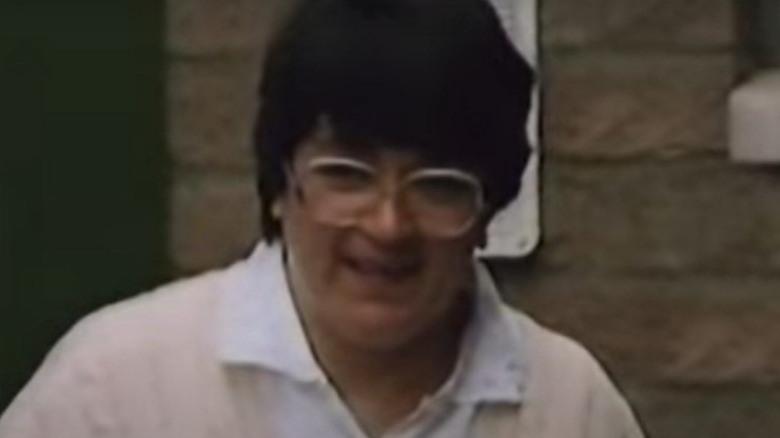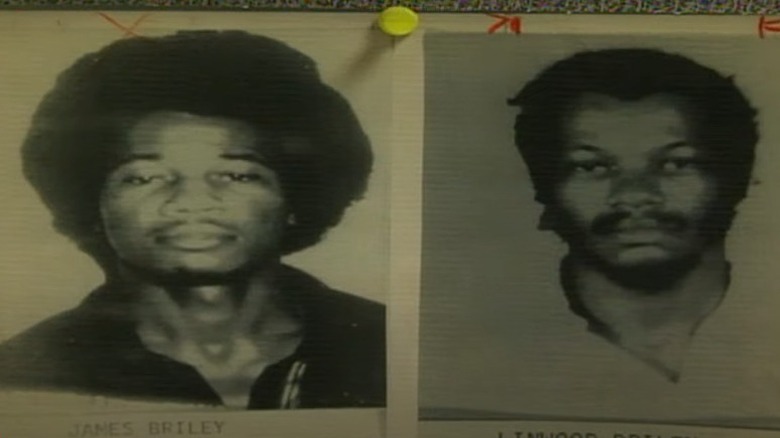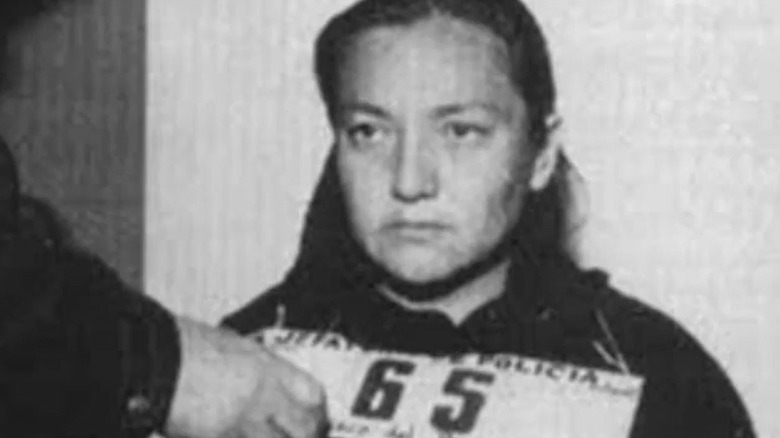The Terrifying Truth About These Serial Killer Families
According to information provided by the FBI, serial killers are not the reclusive loners that many picture them as being. The bureau points out that a good number of killers that walk among us have gainful employment, a functional home life, and even spouses and children. In fact, some of the most notorious serial murderers in recent times have been seemingly typical family types. While the arrests of men like Dennis Rader (the BTK killer) and Green River Killer Gary Ridgway shocked their respective communities, their outward appearance of social normalcy isn't a rare trait within the spectrum of serial killers.
But while it's certain that these killers can certainly be otherwise functional members of society, it's almost equally as certain that they commit their brutality alone and unaided by others. The most famous exception to this line of thought is the Henry Lee Lucas/Ottis Toole murder duo, who may have killed more than 100 people with their combined efforts. Nonetheless, the serial killer generally works in solitude. Yet some chilling statistical outliers might interest true crime enthusiasts. There have been documented cases in history where siblings, cousins, or entire families work in conjunction to eliminate their victims. Though the motives are varied, many are rooted in either financial gains or sexual desire.
Here's a look at some of the most notorious families that used murder as a way to while away the time.
The Bloody Benders
Nearly 4 million Americans and immigrants took advantage of the Homestead Act of 1862 to fulfill their shared dream of establishing a life on free property that belonged to the United States government (via History). Anyone over the age of 21 that was considered the head of the household was eligible to apply for a 160-acre piece of land on the frontier.
Among eager settlers was a family known as the Benders. Staking a claim in southeastern Kansas in 1870, the Bender clan consisted of Ma and Pa Bender, their adult daughter Kate, and an acquaintance named John Gebhardt. The family settled in for several years until the brother of Kansas politician Alexander York was reported missing. William York vanished without a trace, with suspicion falling on the Benders. Slate reports that when questioned, the Benders came off as odd. Though he didn't want to accuse the family of wrongdoing, Alexander felt that this family knew more than they were letting on. The local authorities decided to announce a search of everyone's homes in the area so that the Benders' place could be inspected without officially singling them out.
But when the team arrived, the home was empty. The Benders had fled, never to return. What the search did turn up was the bodies of at least 11 people that the Benders had murdered over the last three years. Most were stuffed in the crawlspace, with some buried in the orchard or thrown into a well.
Fred and Rose West
When 16-year-old Heather West disappeared in 1987, she left behind five siblings that were subjected to the abuse and neglect by their parents. Fred and Rose West eventually had their children removed from their Gloucester, U.K. home in 1992. Their children told social workers that the "family joke" was that their missing sister was buried under the family's patio. Six months later, police decided to investigate. CNN reports that though no missing person case was ever filed on Heather West, the police couldn't find her. Under interrogation, Fred West admitted to killing his daughter, though Rose denied having any part of it.
A warrant was issued, and several human femurs were found in the Wests' garden. Additional searches turned up the remains of several others. With the evidence of additional murders mounting against him, Fred West confessed to two more murders, an 18-year-old named Shirley Robinson and a 16-year-old named Alison Chambers. Days later, he passed a note to his attorney in which he wrote that he wanted to confess to the murders of nine additional people.
His confessional led investigators to the body of the family's 8-year-old stepdaughter Charmaine, who had been killed by Rose in 1971. Fred West concealed the body, and she had never been reported missing. He was charged with 12 murders and committed suicide while awaiting trial, while his wife Rose was convicted and sentenced to life behind bars. How many they actually raped, tortured, and killed may never be fully known.
The Briley brothers
Linwood Briley was 16 when he first committed murder. The Richmond Times-Dispatch reports that the teen shot his neighbor, the widow Orline Christian, in 1971. Released from prison, Briley, his two younger brothers James and Anthony, and a friend Duncan Meekins went on a violent crime spree that both shocked and terrified Richmond, Virginia residents in 1979. With robbery as their primary motive, the foursome didn't want to leave witnesses to their crimes alive. They killed at least 11 people during their spree, including a pregnant woman and a 5-year-old boy. All four were caught, and both Linwood and James were convicted and sentenced to death. Anthony couldn't be linked to any murder, so he was given life. Meekins, 15 at the time of the crimes, was saved from the chair in exchange for his testimony.
As bizarre a story as their crimes were, perhaps the most shocking part of their case was the breakout of death row inmates they helped orchestrate. On May 31, 1984, James and Linwood Briley carried out a well-planned escape from the Mecklenburg Correctional Center. With the help of stashed weapons, they managed to overtake a guard pod. Using the guard's uniforms and riot gear, the Briley's and four other death row inmates forced their way out of the prison (per Richmond Times-Dispatch).
They were caught 20 days later. Linwood was sent to the chair on October 12, 1984, and James took his seat on April 18, 1985.
The Wagner family
On the night of April 22, 2016, eight people were murdered execution-style in their homes. The victims were all members of the Rhoden family, leading investigators to believe that the murders were all connected. The victims were living in three adjacent houses as part of a multi-generational family that included a former married couple, Christopher Rhoden Sr., and his ex-wife Dana. Their children, Christopher Jr., Clarence, and Hannah, also resided on the property, along with the senior Rhoden's brother Kenneth and their cousin, Gary. Also murdered with the family was Hannah Gilley, Clarence Rhoden's fiancé (via People Magazine). Three young children were left unharmed at the crime scene and placed into protective custody after the murders were discovered.
A custody disagreement was shown to be the motive for the murders. The father of Hannah Rhoden's 3-year-old was a man named Jake Wagner, who spent four months planning the murders (per Fox 19). He enlisted the help of his mother and father, Angela and George Wagner, as well as his older brother, George IV (per The Cincinnati Enquirer). The Wagners stormed into each of the Rhoden homes and tried to rid the world of problems tied to Jake's custody dispute.
The Wagners were arrested in 2018. In a plea agreement with the state, Jake pled guilty to the murders in exchange for testimony against his family. He was given life without parole, while his mother was given 30 years. Jake's father and brother have yet to go to trial (per Fox 19).
The Staffleback family
Authorities were no strangers to the home of the Staffleback family in southeastern Kansas. Their cabin was set near the mines and was a well-known brothel. The Staffleback matriarch, Nancy, had moved there from nearby Joplin, Missouri, in 1894 and quickly headed a home that was notorious for petty illegal activity (per Joplin Globe).
In 1897, a drunken miner arrived at the cabin to see Nancy's daughter, Emma. After being refused entry twice by Nancy, his inebriated insistence was rewarded with Nancy chasing him away with a corn knife. In all the excitement, Nancy's partner Charles Wilson and her son Ed chased the fleeing miner with gunfire. Struck with a bullet to the leg, the miner was soon set upon by Ed, who slit his throat with a knife. The body was dumped in a mine shaft.
After someone noticed the body and reported it, the corpse revealed the victim to be Frank Galbraith. In a raid on the cabin, officials members of the family, including Nancy and her sons Ed and George. The arrests prompted George's wife Cora and another working girl Rose Bayne to speak to police about the multitude of crimes the family committed. They told of five additional murders carried out on the property, prompting more charges against the Stafflebacks.
Nancy was sentenced to prison, where she died at the age of 81 in 1909. Her sons Ed, George, and Mike all went away for life for murder and various other crimes.
The Kelley family
Though they were believed to be active for a period of a few months in 1887, the Kelley family allegedly killed as many as 11 people at their Oak City, Kansas tavern.
The New York Sun reports that the family, led by patriarch William Kelley, was aided in the robbery and murders of nine men and two women. Motivated by robbery, the entire family of four was in on the crimes. When travelers stopped at the tavern and needed a place to stay for the night, the Kelleys sized them up and determined if they would be worth robbing. The victim was seated atop a trap door, which dropped them into the cellar. If they didn't die from the fall, they would be later killed by an ax (via The Hillsboro Recorder).
When the family suddenly vanished in December 1887, a traveler stopped by the tavern and noticed a horrible smell. Investigating the basement, he discovered the rotting corpses of several men. After reporting it, a posse was formed to search for the Kelleys. After they were tracked down, William's wife Kate was atop a horse that bucked her, breaking her neck. Bill and Kit, Kelley's son and daughter, were caught and hung by their necks from a tree by the posse. William managed to evade capture for a brief time before he, too, was dancing from the end of a rope.
Gerald and Charlene Gallego
From 1978 to 1980, Gerald and Charlene Gallego went on a tear, kidnapping and brutalizing multiple young women in what would later be described as a method in which Gerald could act out his most violent sexual fantasies (per SF Gate). The couple would lure their victims into their vehicle with "promises of parties or jobs," according to the news outlet. The Gallegos would then rape and torture their victims before bludgeoning them to death.
Before they were finally caught in 1980, they were believed to have killed nine women and one man. Gerald was sentenced to death for his crimes, though he died of cancer while awaiting execution. Charlene agreed to testify against her husband and was only sentenced to serve a sentence of a little more than 16 years. But was Charlene a willing participant in the crimes or a victim of her husband's brutality, forced to commit horrific acts out of fear? Though SF Gate reports that she pled guilty to three of the murders, she denied any involvement in the murders themselves after her release years later. CBS 13 details how Charlene, now free and living under an alias, not only denies killing any of the women but also claims that Gallego gave her no choice but to assist him.
If you or anyone you know has been a victim of sexual assault, help is available. Visit the Rape, Abuse & Incest National Network website or contact RAINN's National Helpline at 1-800-656-HOPE (4673).
The Sawney Bean Clan
Historians debate whether or not there was a notorious clan of 16th-century cannibals living in a cave near well-traveled crossroads in Ayrshire, Scotland. But even if a snippet of the legend of Sawney Bean is true, it's a chilling tale that's sure to send shivers down the spine of any late-night traveler.
The legend surrounds Bean and his wife, who established a home in a cave. A tanner by trade, Bean felt that robbing and killing travelers was a more lucrative vocation. But what to do with the bodies? Bean solved this conundrum by consuming their flesh (via Historic UK). Bean and his wife had many children, who — through years of inbreeding — had children of their own. Over time, a bloodthirsty clan of Bean cannibals resided in the cave, orchestrating attacks on anyone who passed by, subsisting off the flesh of their victims. Their end came after a couple was attacked one night after leaving a nearby fair. The woman was killed and disemboweled at the scene, but the man fought back diligently until a larger group of passersby stumbled across the melee. Outnumbered, the Beans fled to the safety of their cave. Forced out by the law, they were tried and hung by their necks.
Though written about in numerous publications, the validity of the story is questioned. Historian Dr. Louise Yeoman purports that the tale of Sawney Bean was concocted as anti-Scotsman propaganda in the 18th century in response to the Jacobite uprisings (per the BBC).
The Harpe brothers
Legends of America chronicles what might be the United States' first case of serial killings. The murders weren't carried out by a solitary monster but rather by two cousins known in history as the Harpe Brothers. The duo terrorized the states of Tennessee, Illinois, Kentucky, and Mississippi in the latter part of the 1700s. Preying on innocent travelers they met on the road, Micajah and Wiley Harpe would rob, torture, and kill their victims. Caught once in Danville, Kentucky, the pair were able to escape jail before trial. They fled the area to avoid capture by a posse organized by law enforcement.
They were finally tracked down on August 24, 1799. Micajah was shot while trying to escape, confessing to the murders of 20 people as he lay dying. Wiley's escape from the posse was successful, and he soon found himself holed up with the notorious Mason Gang with whom he and his cohort had lived before. Using the alias John Setton, the surviving Harpe proves that there is no honor among thieves. When a bounty was put on the head of the Mason Gang's leader, Harpe killed him, severing his head to show law enforcement and get their reward.
Recognized by authorities, he fled. He was soon after captured, convicted, and executed for murder. His own severed head was placed on a pike as a warning to fellow outlaws. The Harpe Brothers may have killed more than 40 people.
The Tarverdiyeva family
For a solid six years, authorities maintain that a Bonnie and Clyde-like couple terrorized the Rostov region of Russia, killing as many as 30 people (via The Independent). But the couple did not work entirely alone. Inessa Tarverdiyeva and her beau Roman Podkopayev were able to succeed in their criminal activity with the help of Tarverdiyeva's daughter Viktoria as well as Podkopayev's sister and brother-in-law, Anastasia and Sergei Sinelnik. Sergei was a police officer who was able to help the murderous family evade suspicion for years.
With robbery as their primary motive, the gang would leave their home for what were purported to be weekend camping trips that were, in reality, crime sprees (per the Daily Mail). HuffPost reports that they would ambush victims — sometimes entire families — and relieve them of their valuables. At times, the gang would not only kill their marks but also take pleasure in prolonging their agony. One report from the Daily Mail tells of how the gang gouged out the eyes of two teenage girls they attacked. They frequently targeted law enforcement officers, with six among their murder victims.
During an ID check soon after a robbery, The Independent reports that Podkopayev was killed in a shootout by police when they attempted to arrest him. Tarverdiyeva was arrested and charged, as were the Sinelniks and Viktoria Tarvediyeva. When asked why she would commit such heinous crimes, Tarvediyeva quipped, "Money to live and hatred of police officers."
The Gonzalez sisters
During the 1950s and 1960s, Delfina and Maria Gonzàlez Valenzuela were an enterprising pair of siblings that ran a large brothel north of Mexico City. But the bordello was not built on honest means by any accounts. The siblings worked to lure innocent young women into sex work, often by placing ads for maids (via A&E). Held captive, the women would then be forced to act as prostitutes and severely punished for any rebellion. Those who refused or became too ill to engage in sex work were severely beaten or killed. Before the two women were brought to justice, they were responsible for the deaths of at least 80 women.
The New York Times reports that throughout the investigation, 19 other defendants were charged in connection to the crime ring the sisters operated. A court found both sisters guilty, and they were given a maximum sentence of 40 years in prison.
If you or anyone you know has been a victim of sexual assault, help is available. Visit the Rape, Abuse & Incest National Network website or contact RAINN's National Helpline at 1-800-656-HOPE (4673).











